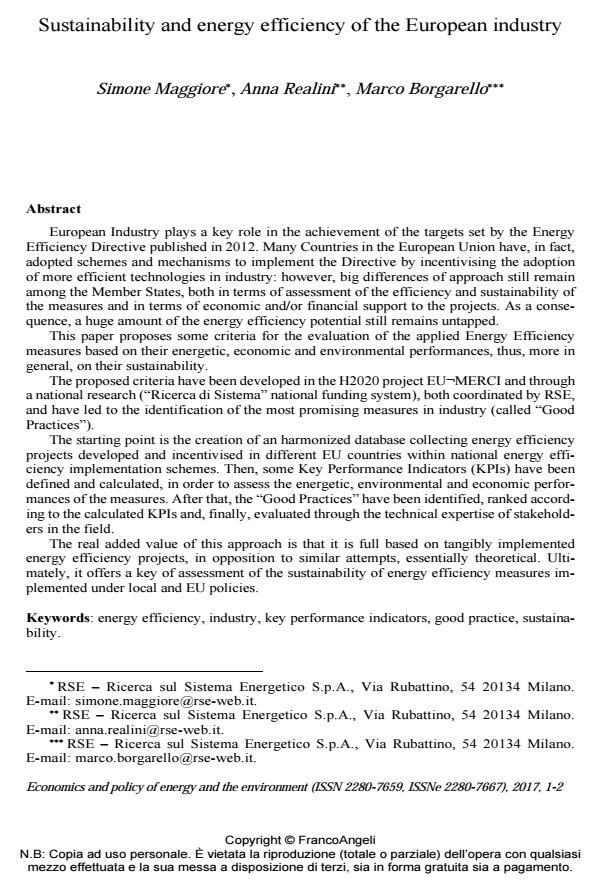Sustainability and energy efficiency of the European industry
Journal title ECONOMICS AND POLICY OF ENERGY AND THE ENVIRONMENT
Author/s Simone Maggiore, Anna Realini, Marco Borgarello
Publishing Year 2017 Issue 2017/1-2
Language English Pages 15 P. 31-45 File size 225 KB
DOI 10.3280/EFE2017-001003
DOI is like a bar code for intellectual property: to have more infomation
click here
Below, you can see the article first page
If you want to buy this article in PDF format, you can do it, following the instructions to buy download credits

FrancoAngeli is member of Publishers International Linking Association, Inc (PILA), a not-for-profit association which run the CrossRef service enabling links to and from online scholarly content.
European Industry plays a key role in the achievement of the targets set by the Energy Efficiency Directive published in 2012. Many Countries in the European Union have, in fact, adopted schemes and mechanisms to implement the Directive by incentivising the adoption of more efficient technologies in industry: however, big differences of approach still remain among the Member States, both in terms of assessment of the efficiency and sustainability of the measures and in terms of economic and/or financial support to the projects. As a consequence, a huge amount of the energy efficiency potential still remains untapped. This paper proposes some criteria for the evaluation of the applied Energy Efficiency measures based on their energetic, economic and environmental performances, thus, more in general, on their sustainability. The proposed criteria have been developed in the H2020 project EU¬MERCI and through a national research ("Ricerca di Sistema" national funding system), both coordinated by RSE, and have led to the identification of the most promising measures in industry (called "Good Practices"). The starting point is the creation of an harmonized database collecting energy efficiency projects developed and incentivised in different EU countries within national energy efficiency implementation schemes. Then, some Key Performance Indicators (KPIs) have been defined and calculated, in order to assess the energetic, environmental and economic performances of the measures. After that, the "Good Practices" have been identified, ranked according to the calculated KPIs and, finally, evaluated through the technical expertise of stakeholders in the field. The real added value of this approach is that it is full based on tangibly implemented en-ergy efficiency projects, in opposition to similar attempts, essentially theoretical. Ultimately, it offers a key of assessment of the sustainability of energy efficiency measures implemented under local and EU policies.
Keywords: Energy efficiency, industry, key performance indicators, good practice, sustainability.
Jel codes: Q3, Q4
Simone Maggiore, Anna Realini, Marco Borgarello, Sustainability and energy efficiency of the European industry in "ECONOMICS AND POLICY OF ENERGY AND THE ENVIRONMENT" 1-2/2017, pp 31-45, DOI: 10.3280/EFE2017-001003